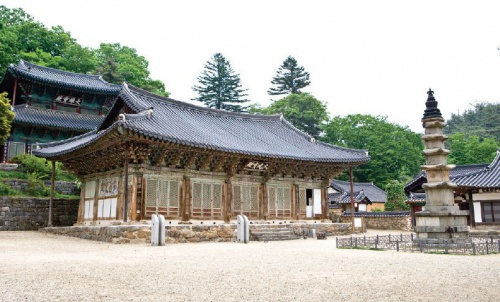"Korea's Religious Places - 1.1.7 Magoksa Temple (Gongju, Chungcheongnam-do)"의 두 판 사이의 차이
(새 문서: ==Magoksa Temple (Gongju, Chungcheongnam-do)== Located in Chungcheongnam-do, near Gongju, Magoksa Temple dates back to the Three Kingdom period (traditional dates 57 BCE–668 CE) an...) |
잔글 (→Magoksa Temple (Gongju, Chungcheongnam-do)) |
||
| 3번째 줄: | 3번째 줄: | ||
Located in Chungcheongnam-do, near Gongju, Magoksa Temple dates back to the Three Kingdom period (traditional dates 57 BCE–668 CE) and is surrounded by mountains and rivers. Its setting is not only beautiful, but somewhat inaccessible; and thus, this temple was one of the few not destroyed by the Japanese during the Imjin War of 1592–1598. Most other temples were destroyed and had to be rebuilt after the war, and often at temples, there were fires that destroyed buildings. Some temple complexes have only a fraction of the buildings they once held. | Located in Chungcheongnam-do, near Gongju, Magoksa Temple dates back to the Three Kingdom period (traditional dates 57 BCE–668 CE) and is surrounded by mountains and rivers. Its setting is not only beautiful, but somewhat inaccessible; and thus, this temple was one of the few not destroyed by the Japanese during the Imjin War of 1592–1598. Most other temples were destroyed and had to be rebuilt after the war, and often at temples, there were fires that destroyed buildings. Some temple complexes have only a fraction of the buildings they once held. | ||
| − | One of the unique features of Magoksa Temple is the stream nearby. It is called Taegeukgang Stream for the shape of the bends of the stream. There the river winds around like the yin-yang circle, called the “Supreme Ultimate” (taegeuk) symbol in Korea. The yin-yang symbol in Korea has mystical powers. The yin-yang theory and the yin-yang symbol were adopted by both Confucians and Daoists in classical China, and spread throughout East Asia. The symbol is important in Korean culture and is even found on the Korean flag today. | + | One of the unique features of Magoksa Temple is the stream nearby. It is called Taegeukgang Stream for the shape of the bends of the stream. There the river winds around like the yin-yang circle, called the “Supreme Ultimate” (''taegeuk'') symbol in Korea. The yin-yang symbol in Korea has mystical powers. The yin-yang theory and the yin-yang symbol were adopted by both Confucians and Daoists in classical China, and spread throughout East Asia. The symbol is important in Korean culture and is even found on the Korean flag today. |
2017년 1월 17일 (화) 23:01 판
Magoksa Temple (Gongju, Chungcheongnam-do)
Located in Chungcheongnam-do, near Gongju, Magoksa Temple dates back to the Three Kingdom period (traditional dates 57 BCE–668 CE) and is surrounded by mountains and rivers. Its setting is not only beautiful, but somewhat inaccessible; and thus, this temple was one of the few not destroyed by the Japanese during the Imjin War of 1592–1598. Most other temples were destroyed and had to be rebuilt after the war, and often at temples, there were fires that destroyed buildings. Some temple complexes have only a fraction of the buildings they once held.
One of the unique features of Magoksa Temple is the stream nearby. It is called Taegeukgang Stream for the shape of the bends of the stream. There the river winds around like the yin-yang circle, called the “Supreme Ultimate” (taegeuk) symbol in Korea. The yin-yang symbol in Korea has mystical powers. The yin-yang theory and the yin-yang symbol were adopted by both Confucians and Daoists in classical China, and spread throughout East Asia. The symbol is important in Korean culture and is even found on the Korean flag today.
Legend has it that the temple was founded by the Silla monk Jajang in 640 although there are those who dispute this claim because Silla Kingdom and Baekje Kingdom, where Magoksa Temple is located, were enemies at the time, just before the unification by Silla Kingdom. The legend also states that Jajang named the temple Magok, meaning flax valley, with the idea that with a temple in this valley, Buddhism would grow rapidly, just like the fast-growing flax plants in the valley.
There are several Treasures (of the second level—National Treasure is highest, Treasure is second, and third are local area designated treasures.) One Treasure is a five-story stone pagoda (Treasure no. 799) that has a top story done in bronze in a style influenced by Tibetan Buddhism. This is said to be one of only five such pagodas in the world. This connection with Tibetan Buddhism shows the international nature of Korean Buddhism. From the earliest days, monks traveled to China and even India, and still today temples host exchanges with monks from other Mahayana lands, and even from the Theravada lands of Southeast Asia.
Magoksa Temple played an interesting role in twentieth-century history. On the grounds of the temple are some Chinese juniper trees planted by the anti-Japanese freedom fighter and president of the Provisional Government of the Republic of Korea, Kim Gu (1876–1949), who hid from the Japanese for a time here.
